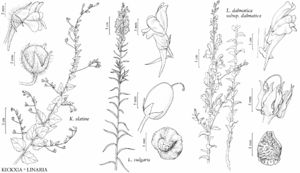Kickxia elatine
Fl. Belg., 35. 1827.
Plants 4–120 cm. Leaves: petiole 2–6 mm; blade: proximal 15–35 × 10–30 mm, base truncate or rounded to cuneate, distal 4–25 × 2–14 mm, base hastate to sagittate, villous with scattered glandular hairs. Pedicels 10–22 mm. Flowers: sepal lobes lanceolate, 3–6 × 1–2 mm, not accrescent, apex acuminate, villous; corolla tube 1–2 mm, palate yellow, inflated, hairy, spurs 5–6 mm, abaxial lobes yellow to violet, adaxial blue to violet, 2–3 mm; abaxial filaments 1.5–2 mm, adaxial 1–1.5 mm; style included, 1.3–1.5 mm; stigma straight. Capsules ovoid-globular, 3–5 mm. Seeds 1–1.5 mm, cristate-tuberculate. 2n = 36.
Phenology: Flowering May–Oct(–Dec).
Habitat: Gravelly or sandy disturbed sites, roadsides, stream banks, gravel bars, glades.
Elevation: 0–900 m.
Distribution
Introduced; B.C., Ont., Ala., Ark., Calif., Conn., Del., Ga., Ill., Ind., Kans., Ky., La., Md., Mass., Mich., Mo., N.J., N.Y., N.C., Ohio, Okla., Oreg., Pa., R.I., S.C., Tenn., Tex., Va., Wash., W.Va., Wis., Eurasia, n Africa, introduced also in Mexico, Central America, South America, Atlantic Islands, Australia.
Discussion
Kickxia elatine differs from K. spuria in leaf and calyx characters. Two subspecies of K. elatine have been described [subsp. elatine and subsp. crinita (Mabille) W. Greuter]; they are poorly defined (D. A. Sutton 1988; M. Ghebrehiwet 2001) and differentiated on the basis of indument density.
Selected References
None.
